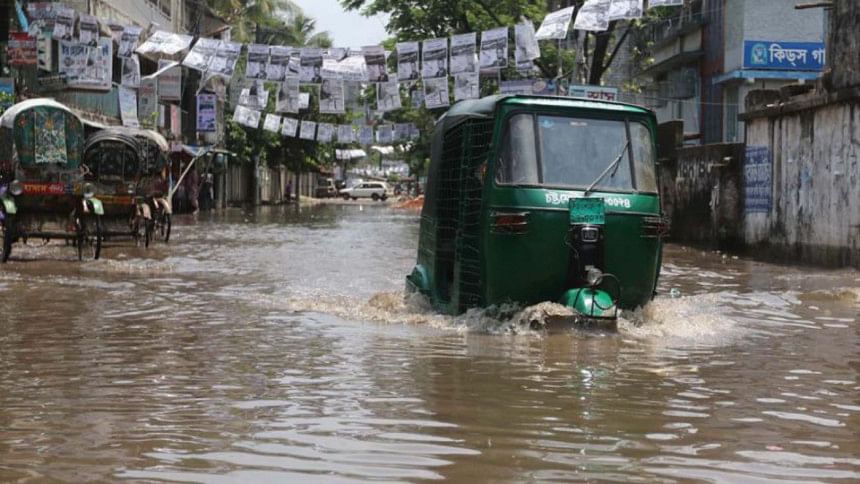A city drowned by faulty planning

On the morning of June 12, after just 63mm of rain, the vast areas in the city stretching from Mirpur to Gulistan to Motijheel to Hatkhola to Shantinogor to Rampura, on one side, and from Lalbagh to Karwan Bazaar to Farmgate and Tejgaon, on the other side, went under knee–deep water. Even posh areas like Banani, Gulshan and Baridhara did not escape the fury of the onrush of water. Hundreds of people were stranded at bus stands and road dividers. With the collapse of the city's transport network, most people were left with no choice but to wade their way back home through knee-deep water.
What took the city dwellers by surprise was neither the volume nor the intensity of that rain, it was almost normal as usual - just 63 mm in this monsoon period - but the impact was almost apocalyptic. Filthy water entered houses in low lying areas of the city, making the lives of residents miserable. The city's overburdened transport network always takes the first hit, but this time the heart of the capital city stopped beating. Low–lying areas like Basabo, Kamalapur, Shantinogor, Nandipara, and Badda went under waist deep water.
As reports reveal, despite the fact that Tk. 3,020 million were spent in the last four years in different projects for arresting water logging, the city is in a dismal state with respect to water supply, sanitation and drainage system. The sewage system covers only 60 percent of the city's population. About 50 percent of the urban waste is allowed to decompose and putrefy on the roadside. Out of the 2,460km long surface drains and the 4,000km long underground drains in the city, there remains about 500km long open surface drains. Quite a substantial amount of the roadside garbage goes into these drains choking them permanently. Thus, even after a mild shower, water cannot flow through the drains and so inundate the road. Although the Dhaka City Corporations (DCC) are primarily responsible for keeping these drains clean, efforts are hardly taken before the onset of monsoon. On the other hand, both Dhaka WASA and DCC are trying to pass the buck to one another.
Even during the Mughal period and British rule, urbanisation took place with the highest attention attached to sewage management. A cursory look at Old Dhaka would reveal that although roads were narrow at that time, drains were quite wide and deep to allow passage of water and waste without creating any hindrance. Dhaka once boasted of 26 canals that allowed for easy and quick disposal of both rainwater and waste without creating waterlogging in the area. However, the canals and marshy lands have now been filled to develop housing for the growing population, business establishments, and educational institutes on the pretext of promoting education and economic boom!
All the canals namely, Ibrahimpur, Mohakhali, Ramchandrapur, Abdullahpur, Kallyanpur and Rupnogor canals have been encroached upon by either poor slum dwellers or greedy land mafias. The width of these canals has shrunk to 30 feet from its original width of 65 feet. Maintenance work has always been very lax, evidenced by the fact that WASA has never thought of keeping the drains and box culverts clean before the advent of the rainy season. All these lapses invite colossal sufferings for the public.
Residential areas like Demra, Jurain, Dolairpar, Nandipara, Kadamtoli, Goran, Khilgaon West Dhanmondi and Rayerbazar etc. have been built on filled land. By constructing embankments around some of these places, we could withstand the onslaught of flood water leaking into these areas partially, but what avenues did we leave to prevent waterlogging due to internal flooding or heavy rainfall?
Every city has its share of dissipation space—wetlands, wastelands and mangroves. In other cases, wetlands and wastelands act like sponges and take off the pressure during heavy rainfall. Shockingly, watershed and sand wetlands surrounding the city have given way to building complexes. This is evidenced all over the city; from midlands to areas bordering rivers and lakes.
Public leaders and policymakers of past governments indulged in the rhetoric of presenting a beautiful and dazzling Dhaka, and occasionally seemed to try to keep the city clean or get rid of the festering malaise but then lapsed into total inaction. A section of public leaders and government officials have allowed buildings and market places to be established without any attention to planning laws and environmental ethics, thereby causing pollution and degradation.
There must be an urban land policy that treats land as resource to be used for the benefit of the citizens. There should also be a framework of urban institutions which can meet the current and emerging requirements of a growing metropolis like Dhaka, as well as a cadre of urban administrators who will have the training and motivation to meet the challenges.
In a sense, Dhaka is being strangulated. Structures built on the banks of rivers Buriganga, Shitalakhya and Turag are good examples of uncontrolled development. Every single inch of encroachment on wetland and river banks is responsible for the present crisis. There had been cloudbursts in the past days, but Dhakaites had never faced a situation like the present. The writing has been on the wall for a long time. It has nothing to do with the quantity of water. It has everything to do with the faulty planning of the city.
The writer is a columnist of The Daily Star.
E-mail: [email protected]

 For all latest news, follow The Daily Star's Google News channel.
For all latest news, follow The Daily Star's Google News channel. 



Comments